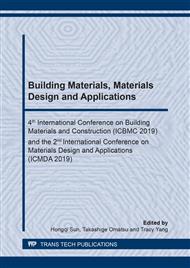[1]
K. Trybalski, W. Kępys, A. Krawczykowska, D. Krawczykowski, D. Szponder, Co-combustion of coal and biomass – chemical properties of ash,, Pol. J. Environ. Stud., vol. 23, 2014, pp.1427-1431.
Google Scholar
[2]
P. Grammelis, G. Skodras, E. Kakaras, Effect of biomass co-firing with coal on ash properties. Part I: Characterization and PDS, Fuel, vol. 85, 2006, pp.2310-2315.
DOI: 10.1016/j.fuel.2006.01.036
Google Scholar
[3]
A.K. James, R.W. Thring, S. Helle, H. S. Ghuman, Ash Management Review—Applications of Biomass Bottom Ash, Energies, vol. 5, 2012, 3856-3873.
DOI: 10.3390/en5103856
Google Scholar
[4]
S. Arvelakis, F. J. Frandsen, Rheology of fly ashes from coal and biomass co-combustion, Fuel, vol. 89, 2010, pp.3132-3140.
DOI: 10.1016/j.fuel.2010.04.019
Google Scholar
[5]
K. Trybalski, W. Kępys, D. Krawczykowski, A. Krawczykowska, D. Szponder, Physical properties of ash from co-combustion of coal and biomass,, Pol. J. Environ. Stud., vol. 23, 2014, pp.1433-1436.
Google Scholar
[6]
R.P. Girón, B. Ruiz, E. Fuente, R.R. Gil, I. Suárez-Ruiz, Properties of fly ash from forest biomass combustion, Fuel, vol. 114, 2013, pp.71-77.
DOI: 10.1016/j.fuel.2012.04.042
Google Scholar
[7]
J. R. Kleven, T. B. Edil, Benson CH. Evaluation of excess foundry system sands for use as sub base material. Trans Res Rec. Washington DC: Transportation Research Board; 2000, pp.40-48.
DOI: 10.3141/1714-06
Google Scholar
[8]
P. Kishor, A.K. Ghosh, D, Kumar, Use of fly ash in agriculture: A way to improve soil fertility and its productivity", Asian J. Agric. Res., vol. 4, 2010, 1-14.
Google Scholar
[9]
T. Abichou, C. H. Benson, T. B. Edil, Database on beneficial reuse of foundry byproducts In: Recycled materials in geotechnical applications (eds.) C. Vipulanandan, D. Elton, Geotechnical Special Publication ASCE, 79, 1998, pp.210-223.
Google Scholar
[10]
B. Carrasco, N. Cruz, J. Terrados, F. A. Corpas, L. Pérez, An evaluation of bottom ash from plant biomass as a replacement for cement in building blocks, Fuel, vol., 118, 2014, 272-280.
DOI: 10.1016/j.fuel.2013.10.077
Google Scholar
[11]
M. Ulewicz, J. Jura, Effect of fly and bottom ash mixture from combustion of biomass on strength of cement mortar, E3S Web of Conferences 18, 01029 (2017),.
DOI: 10.1051/e3sconf/20171801029
Google Scholar
[12]
J. Rosales, M. Cabrera, M. G. Beltrán, M. López, F.Agrela, Effects of treatments on biomass bottom ash applied to the manufacture of cement mortars, Journal of Cleaner Production, vol. 154, 2017, 424-435.
DOI: 10.1016/j.jclepro.2017.04.024
Google Scholar
[13]
E. S. Abdrakhimova, V. Z. Abdrakhimov, Characterization of a ceramic composite material based on beidellite clay and ash and slag waste, Solid Fuel Chem., vol. 46, 2012, pp.185-190.
DOI: 10.3103/s0361521912030020
Google Scholar
[14]
L. Pérez-Villarejo, D. Eliche-Quesada, Fco. J. Iglesias-Godino, C. Martínez-García, Fco. A. Corpas-Iglesias, Recycling of ash from biomass incinerator in clay matrix to produce ceramic bricks, J. Environ. Manage., vol. 95, 2012, pp.349-354.
DOI: 10.1016/j.jenvman.2010.10.022
Google Scholar
[15]
T. R. Naik, R. N. Kraus, Y. M. Chun, W. B. Ramme, S. S. Singh, Properties of field manufactured cast-concrete products utilizing recycled materials, J. Mater. Civil Eng., ASCE 15, 2003, pp.400-407.
DOI: 10.1061/(asce)0899-1561(2003)15:4(400)
Google Scholar
[16]
M. Karaşahin, S. Terzi, Evaluation of marble waste dust in the mixture of asphaltic concrete, Constr. Build. Mater., vol. 21, 2007, pp.616-620.
DOI: 10.1016/j.conbuildmat.2005.12.001
Google Scholar
[17]
S. Fiore, M. C. Zanetti, Foundry wastes reuse and recycling in concrete production. Am. J. Environ. Sci., vol. 3, 2007, pp.135-42.
Google Scholar
[18]
S. Javed, C. W. Lovell, L. E. Wood, Waste foundry sand in asphalt concrete. Trans. Res. Board, 1437, 1994, pp.27-34.
Google Scholar
[19]
R. Rajamma, R. J. Ball, L.A.C. Tarelho, G. C. Allen, J. A. Labrincha, V. M. Ferreira, Characterisation and use of biomass fly ash in cement-based materials, J. Hazard. Mater., 172, 2009, p.1049–1060.
DOI: 10.1016/j.jhazmat.2009.07.109
Google Scholar
[20]
A. A. T. Masiá, B. J. P. Buhre, R.P. Gupta, T. F. Wall, Characterising ash of biomass and waste, Fuel Process. Technol., vol. 88, 2007, pp.1071-1081.
DOI: 10.1016/j.fuproc.2007.06.011
Google Scholar


